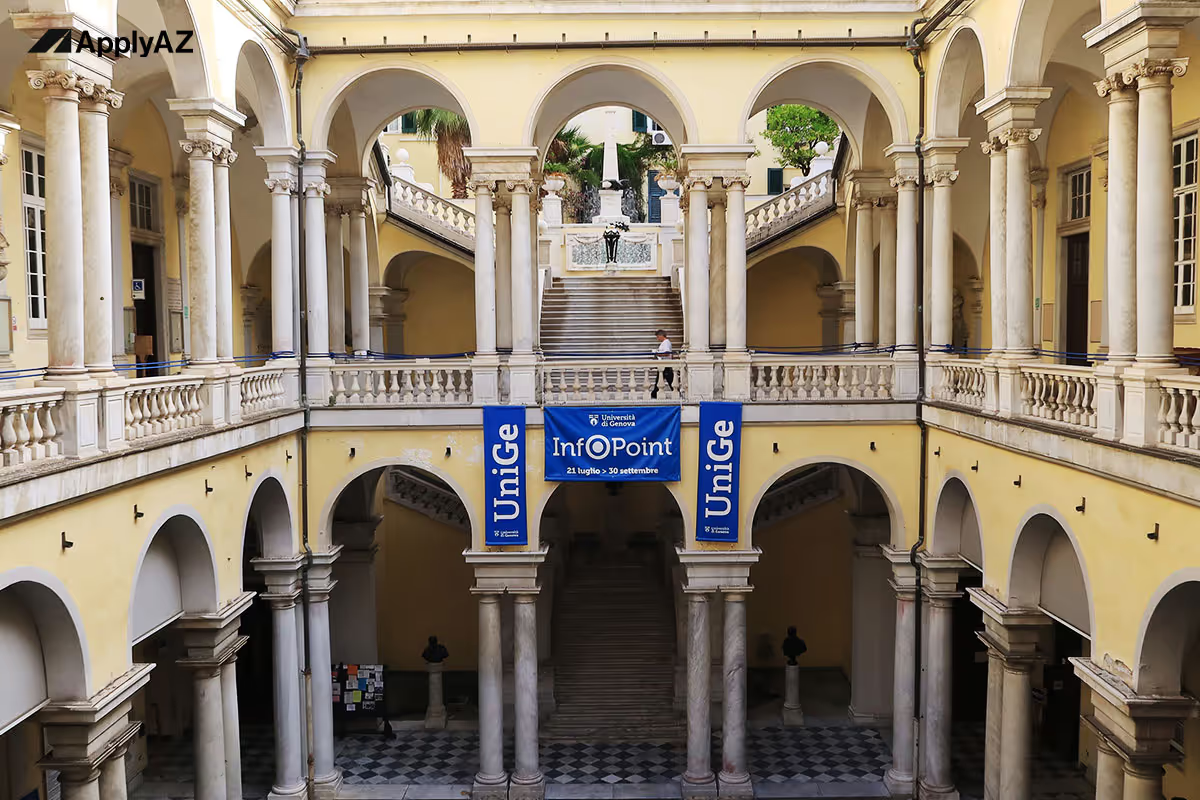Heading
Heading








University of Genoa
English‑taught programmes in Italy: why choose the University of Genoa
Founded in 1481 and consistently ranked among Europe’s leading maritime and engineering hubs, the University of Genoa offers more than 40 degree tracks taught partly or fully in English. This makes it one of the most versatile options for students seeking English‑taught programs in Italy while paying the regulated fees of public Italian universities. Incomes under specific thresholds can unlock the DSU grant, bringing total costs close to the levels often associated with tuition‑free universities Italy commentators mention. Key departments include naval architecture, robotics, computer science, biotechnology, and economics—each anchored by research centres that attract EU Horizon funding and private‑sector contracts.
Living and learning in a historic port city
Genoa stretches between mountains and sea, giving students a mild climate—winter averages 10 °C and summers hover around 28 °C. Shared flats in neighbourhoods like San Fruttuoso or Albaro cost roughly €300–€350 per month, and a €25 student travel pass covers buses, funiculars, and seaside trains. Cafeteria meals drop to €4 or even zero when the DSU grant applies. Cultural life blends Renaissance palaces, street‑art lanes, and open‑air concerts on the harbour. University sports clubs organise sailing, climbing, and coastal hikes, while language‑exchange cafés help you practise Italian after lectures.
Careers, internships, and industry links
Genoa is Europe’s busiest Mediterranean port and the core of Italy’s “Blue Economy.” Maritime giants, shipyards, and logistics groups recruit engineering and business students for roles in vessel design, supply‑chain analytics, and environmental compliance. The city also hosts the Italian Institute of Technology, famous for humanoid robots and smart materials—ideal for internships in AI, neuroscience, or nanotech. Biomedical start‑ups cluster around the university hospital, offering traineeships in gene therapy and medical imaging. Tourism and yachting sectors create seasonal part‑time jobs, useful for earning while studying. Career Services run bilingual CV workshops and link graduates to Erasmus+ traineeships across the EU.
Funding and academic support
Tuition scales from about €600 to €2 500 per year, depending on family income. Scholarships for international students in Italy include merit awards for high GPAs, fee waivers for refugee status, and lab assistantships that pay hourly. The DSU grant can waive tuition entirely, provide free meals, and contribute up to €7 000 toward rent and books—renewable when you pass 30 ECTS each year. The International Student Office helps with visa paperwork, health insurance, and accommodation lists, while the Language Centre offers free Italian courses from A1 to C1.
An inviting mix of heritage and innovation
Studying in Genoa means analysing wave mechanics in class and watching cargo ships glide past medieval city walls after hours. It means prototyping underwater drones in cutting‑edge labs, then testing them in the Ligurian Sea. Most of all, it means joining a diverse student body that values both tradition and forward‑thinking research. Choose Genoa if you want the networking ease of a medium‑sized city, the research muscle of a centuries‑old university, and cost structures that remain manageable thanks to Italy’s public‑education model and the DSU grant.
Ready for this programme?
If you qualify and we still have a spot this month, we’ll reserve your place with ApplyAZ. Our team will tailor a set of best-fit majors—including this course—and handle every form and deadline for you. One upload, many applications, guaranteed offers, DSU grant support, and visa coaching: that’s the ApplyAZ promise. Start now and secure your spot before this month’s intake fills up.
Chemical and Process Engineering (LM‑22) at University of Genoa
1. Why this master stands out among English‑taught programs in Italy
In the first weeks of searching for English‑taught programs in Italy, you will see four ideas repeated online: study in Italy in English, scholarship support, tuition‑free universities Italy, and the reliability of public Italian universities. This Chemical and Process Engineering LM‑22 degree brings those ideas together. You study entirely in English, follow the slim tuition bands set for public Italian universities, and remain eligible for the DSU grant plus other scholarships for international students in Italy. Your net cost can drop near numbers people quote for tuition‑free universities Italy, yet you work with leading faculty on hydrogen, carbon capture, and pharmaceutical reactors.
2. Curriculum: four semesters, 120 ECTS, industry‑aligned
2.1 Semester 1 – molecular to process scale
- Advanced Thermodynamics (9 ECTS) – Fugacity, activity models, and phase equilibria; weekly Aspen Plus workshops benchmark VLE predictions.
- Transport Phenomena (6 ECTS) – Momentum, heat, and mass transfer in laminar and turbulent flows; CFD labs visualise boundary layers.
- Catalysis and Reaction Engineering (6 ECTS) – Kinetics, reactor design, and catalyst deactivation; lab teams test heterogeneous beds for green ammonia.
- Process Simulation Basics (4 ECTS) – Steady‑state mass and energy balances using Python and spreadsheets.
- Scientific Writing and Presentation (5 ECTS) – Abstract crafting, figure design, and peer‑review etiquette.
2.2 Semester 2 – optimisation and sustainability tools
- Process Control and Automation (8 ECTS) – Dynamic modelling, PID tuning, and multivariable control; students code MPC in MATLAB Simulink.
- Separation Processes (6 ECTS) – Distillation, extraction, membranes, and heat‑integrated columns; HYSYS design challenge optimises energy use.
- Life‑Cycle Assessment and Circular Design (6 ECTS) – ISO 14040 methodology, cradle‑to‑gate inventories, and eco‑indicator weighting.
- Elective A (4 ECTS) – choose Bio‑process Engineering, Nano‑materials Synthesis, or Energy Storage Systems.
- Safety and Risk Management (4 ECTS) – HAZOP studies, fault‑tree analysis, and Seveso directives; case essays reflect on historical incidents.
2.3 Semester 3 – integration and innovation
- Advanced Process Simulation (8 ECTS) – Flowsheeting with recycle loops, pinch analysis, and dynamic start‑up models.
- Renewable Energy Conversion (6 ECTS) – Hydrogen production, bio‑refineries, carbon capture, and life‑cycle cost comparison.
- Project Management for Chemical Plants (4 ECTS) – Gantt charts, budgeting, procurement, and agile sprint reviews.
- Elective B (4 ECTS) – options include Pharmaceutical Engineering, Offshore Process Facilities, or Machine Learning for Process Analytics.
- Innovation Lab (6 ECTS) – six‑week sprint: teams redesign a CO₂‑capture skid, create a P&ID, and present CAPEX‑OPEX numbers to industry mentors.
2.4 Semester 4 – internship and thesis
- Professional Internship (14 ECTS) – 350 hours minimum in a refinery R&D unit, pharma scale‑up centre, or hydrogen pilot plant. Tasks may include CFD optimisation of heat exchangers, LCA reporting, or DSC analysis of catalysts.
- Master’s Thesis (16 ECTS) – original research under joint academic–industry supervision. Recent topics: “Enzyme‑assisted biodiesel in continuous flow,” “Dynamic modelling of cryogenic air separation,” and “Machine‑learning prediction of fouling in seawater desalination.” Goal: conference paper or patent application.
3. Laboratories and digital infrastructure
- Reaction Engineering Suite – Fixed‑bed reactors, microfluidic chips, and calorimeters.
- Separation Pilot Hall – 5‑m packed distillation column, UF/RO membrane skid, and adsorption beds.
- Process Control Room – DCS consoles, PLC panels, and virtual plants for alarm‑handling drills.
- Computational Cluster – 4 000 CPU cores, GPUs, and licences for Aspen Plus, ANSYS Fluent, COMSOL, and Python libraries.
- Materials Characterisation Lab – GC‑MS, FT‑IR, XRD, SEM, and BET surface area analysis.
Booking is online; instrument ratios ensure a maximum of four students per rig during peak weeks.
4. Skill set you will master
- Build detailed mass‑energy balances and simulate large process flowsheets.
- Design reactors and separation trains that meet safety, quality, and sustainability targets.
- Code custom scripts in Python for data reconciliation and optimisation tasks.
- Perform life‑cycle assessments and interpret carbon‑footprint metrics for decision‑making.
- Draft PFD, P&ID, and control narratives aligned to ISA standards.
- Manage projects, budgets, and multidisciplinary teams in English.
5. Research hotspots and industry engagement
Faculty coordinate EU consortia on:
- Hydrogen carriers and fuel‑cell integration.
- Bio‑refinery valorisation of agricultural waste.
- CO₂ utilisation in polymer production.
- Digital twins for predictive maintenance.
Students join as paid assistants, capture experimental data, and co‑author journal articles. Corporate supporters—Eni, Maire Tecnimont, Pfizer, and Saipem—fund case studies, sponsor scholarships, and recruit interns straight into graduate programmes.
6. Career trajectories and professional licences
Typical roles
- Process engineer in oil‑and‑gas transition units, hydrogen start‑ups, or pharma scale‑up lines.
- Control and automation specialist configuring DCS and digital twins.
- Sustainability analyst performing LCA for chemical portfolios.
- R&D scientist in catalysis, membranes, or bio‑based chemicals.
- PhD candidate in reaction engineering, energy systems, or circular‑economy materials.
Professional accreditation
The LM‑22 qualifies you to sit the Italian State Examination (Esame di Stato) for chemical engineers, enabling registration and EU recognition. Coursework preps you for Six Sigma Green Belt and TÜV Process Safety certifications.
7. Funding routes: keep costs near tuition‑free universities Italy
Tuition
Because the degree belongs to public Italian universities, fees scale with income—from €900 to about €2 500 annually.
DSU grant
You may receive:
- Complete tuition waiver.
- Meal vouchers or free cafeteria access.
- Rent subsidy or dorm room.
- Annual stipend up to €7 000 for living expenses (30 ECTS required for renewal).
Additional scholarships for international students in Italy
- Merit discounts for GPA ≥ 3.5/4.0.
- Lab‑assistant contracts in first‑year fluid mechanics courses.
- Erasmus+ grants for a semester at partner universities in Germany or Finland.
- Corporate bursaries: €3 000–€5 000 for hydrogen or pharma thesis topics.
Combining these can reduce your cost base to levels similar to tuition‑free universities Italy while retaining sophisticated labs and supervisory time.
8. Admissions checklist and ApplyAZ support
- Bachelor’s degree in chemical engineering, chemistry, process engineering, or related (180 ECTS).
- Completion of thermodynamics, transport phenomena, and calculus sequences.
- English proof—IELTS 6.5, TOEFL 90, or certified English‑medium bachelor.
- Application folder—CV, transcript, passport, motivation letter, two references.
- Online interview—20 minutes: solve a quick energy balance, discuss a design project, and outline career goals.
9. Recap: five reasons this LM‑22 belongs on your shortlist
- Full English delivery within a robust European research university.
- Balanced mix of simulation, lab experimentation, and sustainability metrics.
- Fees aligned with public Italian universities plus DSU grant and merit funding.
- Corporate links ensure internships, case data, and job leads.
- Global licence portability via Esame di Stato and EU professional standards.
Ready for this programme?
If you qualify and we still have a spot this month, we’ll reserve your place with ApplyAZ. Our team will tailor a set of best-fit majors—including this course—and handle every form and deadline for you. One upload, many applications, guaranteed offers, DSU grant support, and visa coaching: that’s the ApplyAZ promise. Start now and secure your spot before this month’s intake fills up.

They Began right where you are










